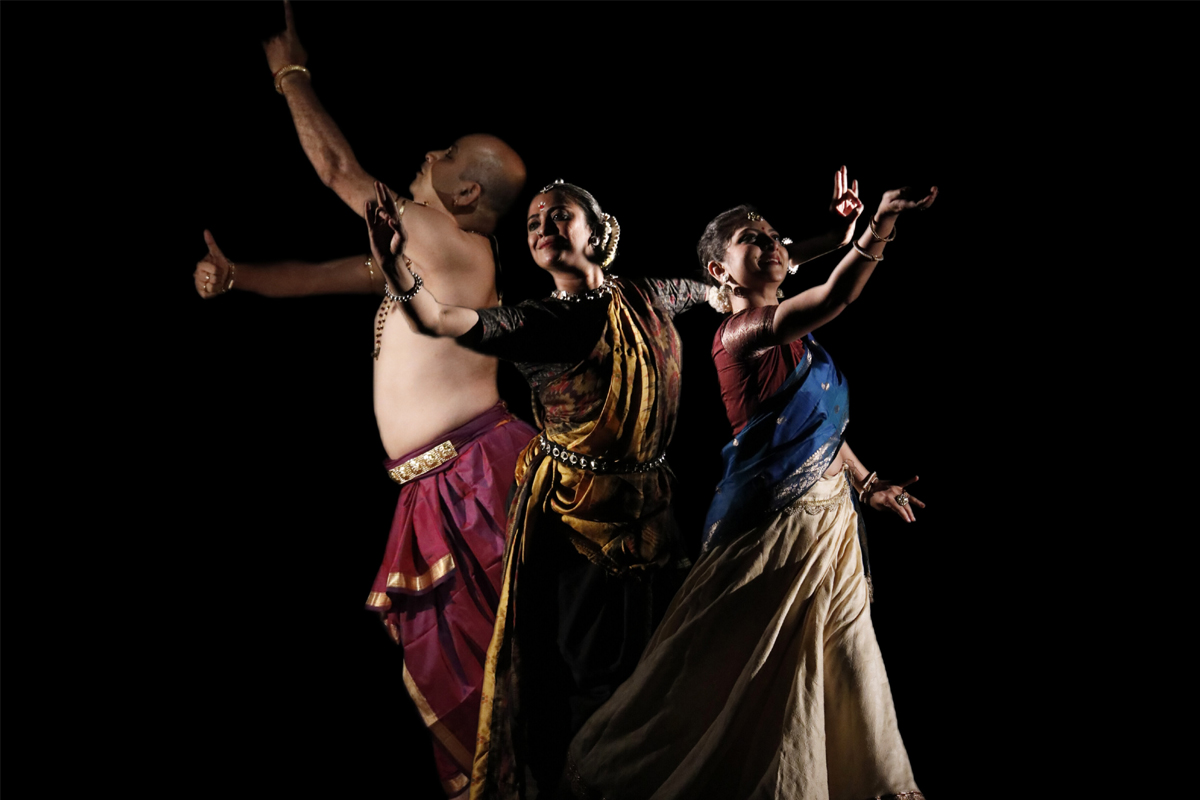Chitragati was a choreographic presentation by team Aakaar, consisting of Shshwati Garai Ghosh, Rajdeep Banerjee, and Sohini Debnath. It unveiled creative renditions interwoven as a collective. It is an ongoing research project through a collaborative artistic venture. Recently, they premiered individual choreographic attempts in their distinctive style of story-telling.
“Being herself” by Shashwati Garai Ghosh was the tale of a woman of grace and pride who lived life on her own terms and had full confidence in her belief in being what she was. Overwhelmed by the emotion of love, she adorned herself with passion and care. When love came to her, she celebrated it by dressing up according to her whims and fancy, and she danced. Though she spoke, she was not heard, and ultimately, she was the one who lost everything. She was the princess of Lanka, stamped as a demon, resilient yet strong. She was Surpanaka, the sister of Ravana, the king of Lanka. In the story, she stood up to hear her inner voice. One fine day in the deep forest of Panchavati, her eyes met the eyes of Arya Putra-Ram, and it was love at first sight, which was pure and sacred from her side. To display her happiness, she demonstrated her desire to impress. It was her very own Shringar Rasa. Love had blinded her, and she wanted Ram to reciprocate her approaches, but “Ekapatnivrata” Ram did not. When she saw Sita, tragedy struck her. A chain of events followed one after the other, causing complete destruction. The demon lost herself.
But she stood rock-like with her inner voice speaking to her. The efficacious telling of the story was spellbinding. The music of the piece contributed much to making the drama intense in its portrayal of the rawness of the piece. Rabindranath Tagore’s lyric ‘Krishnakoli’ was very effective in bringing out the nuances of the dramatic elements of “Being herself”. The choreographer used Sadri language—a dialect of Bhojpuri used in the eastern regions of the country—and Odissi classical ideas to develop layers throughout to build a realistic picture of the fiercely independent and freedom-seeking woman. The concept and the script were also by Shashwati Garai Ghosh’. Her senior students, Joyita Pal, Agnisha Basak, and Minakshi Kundu, were her supporting dancers. Music Director Srijan Chatterjee played a pivotal role in the success of the piece. The voiceover of Dipannita Acharya in the song Krishnakali gave me goosebumps. The Santhali voice of Kalpana Mahato brought out its true essence. The rhythm was composed by Rohit Pradhan, and the flute was played by Tarun Mukherjee.
“Sthapana” by Bharatanatyam practitioner Rajdeep Banerjee was a conversation between mother Kaikei and her son Bharat, taken from the great Indian epic, the Mahabharata. Sthapana was in the form of a dialogue that raised serious questions about relationships, wisdom, truth, and right and wrong.
According to Bharat, Ram is not just a hero but a god. Ram has a sensibility. He is conscious with a feeling for human beings. Sthapana established this thought in a very dignified presentation. In a divided country like ours, Ram was made very relevant and universal by Rajdeep Banerjee. Followers of the philosophy of Tagore, who wrote, “Open thine eyes and see thy God is not before thee! He is there where the tiller is tilling the hard ground and where the path-maker is breaking stone.” -who would not like to put Ram on a pedestal and pray to him, would be happy to be with him in his human quality. Vocal rendition by Debarshi Bandhopadhyay; Mridangam by K. Dakshinamurti; and talam kept by Kaliswaran Pillai added to the aestheticism of the piece. Flautist Rupak Mukherjee and pianist Mandola Joy created beautiful and unmatchable music. Rajdeep Banerjee, who has a good foothold over the Bharatanatyam, is a stickler for perfection, and he delivered it fittingly.
Chitragati presented Sohini Debnath, a disciple of Rani Kaarna, in Ninaad in Kathak style. An excellent Kathaka, she related her story in the language of fluid Kathak. The beginning of a time cycle possesses all the colours of old and yet is in itself a new beginning. The taal chakra mirrors the progress of time from one ‘sum’ to another. The music for the piece was conceived by Sri Naresh Mukherjee. Mathur was a viraha parva to be found in Vaishbav Kirtan, where Krishna left for Mathura, never to return to Radha. This was the first time Kathaka Sohini Debnath has attempted to perform a traditional Kirtan. Her interpretation of “Mathur” is not just a portrayal of yearning; it also raises questions of self-identity and hallowed presumptions, revolving around the character of Radha. Radha and her waiting have almost always merged into one celebrated symbol of endurance and an icon of faith that stretches beyond Horizon. She is the eternal ardhangini of Krishna. She has always been portrayed as incomplete without him. Sohini Debnath has initiated a different line of thought with her rendition of Mathur. Rajeswary Ganguly Banerjee’s vocal singing has touched the hearts of the audience. Srikhol played by Gautam Bhattacharya and Sitar by Sourabh Ganguly, and the flute music of Panchajanya Dey, gave the concept and choreography of Sohini an untold dimension.
Credits for Chitragati Collective go to music designer Sayak Mitra, who also gave the voiceover along with Deepmoy Das. Instruments played were by Mandola Joy, Prabir Chatterjee (percussionist), and Rick Mukherjee (flautist). The lights were designed by Amlan Chaudhary.
Chitragati was also interwoven with different lyrical landscapes, with individual choreographic attempts in their distinctive style of storytelling. The presentation had a well-defined introduction and conclusion. The students of all three storytellers enthralled the audience with their bit of preparing the audience and summing it up beautifully in the end.
The writer is a senior dance critic












